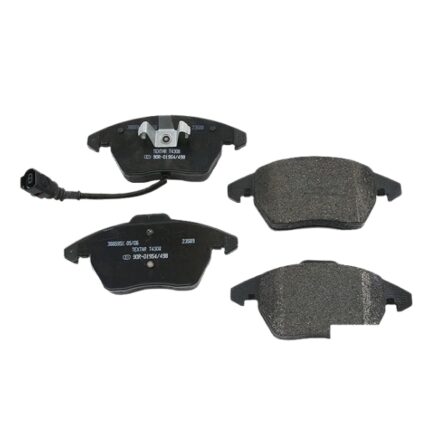Get Rear Wiper Blade VW Golf GTI/Golf R Mk6/Mk7 5K6955427A
Wiper blades are essential for maintaining clear visibility while driving in adverse weather conditions. They are a critical component of a vehicle’s windshield wiper system, designed to remove rain, snow, ice, and debris from the windshield. This guide explores the function, types, signs of wear, and maintenance of wiper blades, offering a comprehensive understanding of their importance in vehicle safety.
Function and Importance
Wiper blades play a vital role in ensuring driver safety by providing a clear view of the road. Their primary functions include:
- Visibility Enhancement: By clearing the windshield of water, snow, or debris, wiper blades ensure that the driver has an unobstructed view, which is crucial for safe driving.
- Safety Improvement: Effective wiper blades help maintain proper visibility during adverse weather conditions, reducing the risk of accidents and improving overall road safety.
- Maintenance of Windshield Integrity: Wiper blades also help prevent the buildup of grime and dirt that can potentially damage the windshield over time.
Types of Wiper Blades
Wiper blades come in various designs and materials, each suited to different driving conditions and preferences:
- Conventional Wiper Blades:
- Construction: Consist of a rubber blade attached to a metal frame with a series of small pivot points.
- Performance: They are the most common type and are often cost-effective but may not perform as well in extreme weather conditions.
- Beam Wiper Blades:
- Construction: Feature a one-piece design with a flexible rubber blade and no external frame.
- Performance: They provide consistent pressure across the windshield and are less likely to freeze or clog with snow. They offer improved performance in harsh weather conditions and are quieter during operation.
- Hybrid Wiper Blades:
- Construction: Combine elements of conventional and beam wipers, featuring a metal frame covered with a rubber shell.
- Performance: They provide the stability of conventional wipers and the aerodynamic advantages of beam wipers. They are effective in various weather conditions and often offer better performance and durability.
- Winter Wiper Blades:
- Construction: Designed specifically for cold climates, with a protective cover to prevent snow and ice from accumulating.
- Performance: They offer superior performance in snow and ice, preventing the blades from becoming clogged and ensuring effective clearing.
Signs of Worn Wiper Blades
Recognizing the signs of worn wiper blades is crucial for maintaining visibility and safety. Key symptoms of worn wiper blades include:
- Streaking or Smearing:
- Description: When the wiper blades leave streaks or smears on the windshield, it indicates that the rubber is worn out or damaged.
- Cause: The rubber may have hardened, cracked, or become uneven, reducing its effectiveness.
- Chattering or Squeaking:
- Description: If the wiper blades make a chattering or squeaking noise during operation, it suggests that the blades are not making proper contact with the windshield.
- Cause: This can be due to worn-out rubber, a misaligned wiper arm, or debris caught between the blade and windshield.
- Skipping or Missed Spots:
- Description: Wiper blades that skip or miss spots on the windshield indicate that the blade is no longer making consistent contact with the glass.
- Cause: This can be due to a loss of flexibility in the rubber or issues with the wiper arm.
- Cracks or Tears in the Rubber:
- Description: Visible cracks, tears, or chunks missing from the rubber blade are clear indicators of wear and damage.
- Cause: These issues can result from exposure to extreme temperatures, UV rays, or general wear and tear.
- Reduced Wiper Performance:
- Description: If the wiper blades struggle to clear water, snow, or debris effectively, it signifies that they may need replacement.
- Cause: This can be due to worn-out rubber or other damage affecting the blade’s performance.
Diagnosing and Replacing Wiper Blades
Diagnosing wiper blade issues involves a simple visual and functional inspection. Here’s how to evaluate and replace wiper blades:
- Inspection:
- Check the rubber blade for signs of wear, cracks, or damage.
- Observe the performance of the wipers during operation, noting any streaking, skipping, or noise.
- Replacement:
- Choosing Replacement Wipers: Select the correct size and type of wiper blades for your vehicle, as specified in the owner’s manual or by using an online fitment guide.
- Installation:
- Lift the wiper arm away from the windshield.
- Release the old wiper blade from the arm by pressing the release tab or button.
- Attach the new wiper blade by aligning it with the wiper arm and securing it in place.
- Lower the wiper arm back onto the windshield.
Maintenance Tips
Proper maintenance can extend the lifespan and performance of wiper blades:
- Regular Cleaning:
- Clean the windshield and wiper blades regularly to remove dirt and debris that can affect performance and cause wear.
- Use a soft cloth and mild soap solution to wipe the blades and windshield.
- Check for Proper Alignment:
- Ensure that the wiper blades are properly aligned and making full contact with the windshield.
- Misalignment can lead to uneven wear and reduced effectiveness.
- Replace Worn Blades Promptly:
- Replace wiper blades at least once a year or as soon as signs of wear are detected.
- Regular replacement ensures optimal performance and safety.
- Avoid Using Wipers on Ice or Snow:
- Clear off snow and ice from the windshield before using the wipers to prevent damage to the blades and wiper mechanism.
Follow us on Facebook for more parts.



